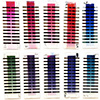| Apr 30, 2025 |
New study explores the key mechanisms that allow certain organic photovoltaic cells to maintain high efficiency even when the active layer is thicker – an essential requirement for large-scale, roll-to-roll manufacturing.
|
|
(Nanowerk News) Researchers from the Institute of Materials Science of Barcelona (ICMAB-CSIC), in collaboration with Heidelberg University, Universidade da Coruña, and the EURECAT Technology Center, have made significant progress toward scalable organic solar technologies.
|
|
Their recent study, published in Advanced Energy Materials (“What Makes Thickness‐Tolerant Organic Solar Cells?”), explores the key mechanisms that allow certain organic photovoltaic cells (OPVs) to maintain high efficiency even when the active layer is thicker—an essential requirement for large-scale, roll-to-roll manufacturing.
|
|
Organic solar cells are emerging as a sustainable alternative to traditional silicon-based photovoltaics. Unlike their rigid counterparts, OPVs use carbon-based materials to harvest light and generate electricity. Their production promises to be more cost-effective and environmentally friendly. However, achieving high performance with thick active layers remains a major challenge, especially for large-scale production techniques such as roll-to-roll printing.
|
 |
| Organic solar cell samples. (Image: ICMAB-CSIC)
|
|
The research team, led by ICMAB researcher Mariano Campoy-Quiles, investigated how certain materials behave when the active layer reaches several hundred nanometers in thickness. This thickness is desirable for scalable fabrication using printing techniques similar to those used in traditional ink-based printing.
|
|
By analyzing thickness-dependent performance data collected over several years, they identify key material properties—such as charge mobility, energy level alignment, and blend morphology—that contribute to this robustness.
|
|
Mariano Campoy-Quiles, ICMAB researcher and co-author of the study, emphasized the broader goal of the work: “Our aim was to understand how to make high-efficiency organic solar cells with thick active layers, as required for roll-to-roll processing. This work is the result of a long-standing effort and collaboration, combining experimental insight with theoretical modeling.”
|
More than 700 devices and 20 material combinations analyzed
|
|
Using artificial intelligence and advanced simulation tools, the team analyzed 720 solar cell devices across 20 different material combinations. By doing so, they were able to identify key trends and predict which combinations are most promising for efficient thick-layer performance.
|
|
The study distinguished between two main groups of photoactive materials: Thickness-sensitive materials, which lose efficiency as the active layer becomes thicker due to poor charge extraction. Thickness-tolerant materials, which continue to perform well even at thicknesses above 200 nanometers.
|
Monte Carlo simulations and machine learning tools
|
|
To understand how these materials behave at the electronic level, the researchers employed Kinetic Monte Carlo (KMC) simulations to model charge transport within the devices. Additionally, machine learning algorithms, specifically decision tree-based models, helped uncover patterns in the performance data gathered over several years.
|
|
One major finding was that optimal performance in thick active layers is achieved when the two organic semiconductors in the blend absorb light in complementary spectral ranges and are mixed in balanced proportions. This maximizes light absorption and charge generation, even at higher thicknesses.
|
|
“We identified the material properties—such as charge mobility, energy level alignment, and blend morphology—that contribute to thickness robustness,” noted Campoy-Quiles.
|
Toward more efficient and sustainable solar energy
|
|
This advancement is critical for enabling large-scale manufacturing of organic solar cells using printing techniques. These methods are more economical, scalable, and sustainable, and could help accelerate the mass adoption of organic photovoltaics.
|
|
The team believes the insights gained from this study will not only improve performance and stability in OPVs but also bring the technology closer to commercialization for both indoor applications (such as IoT devices) and outdoor uses, including in greenhouses and portable energy systems.
|
|
Campoy-Quiles expressed his gratitude for the collaborative nature of the research: “I want to thank the team of Martijn Kemerink at Heidelberg University and Xabier Rodríguez-Martínez at Universidade da Coruña for their invaluable contributions, as well as the collective effort of past and present members of my FOREMATICS group. This collaboration has been essential to advancing our understanding of OPV technology.”
|
|
These findings provide valuable guidance for designing OPV materials and device architectures that are more tolerant to fabrication imperfections—an essential step toward scalable, industrial production of organic solar technologies. This work represents a major advance toward the commercialization of OPVs, contributing to more accessible and sustainable energy solutions.
|


